How to BEND on Guitar. Different TYPES of String Bending: How to Intone a note Correctly and Avoid Unwanted Noises.
One of the characteristics of the guitar, and in particular the electric guitar, is the possibility of string bending.
With this resource we can give our music expressiveness anf feeling, with all kinds of moans, screams and growls. Achieving an expressiveness that we could never achieve with another instrument. Later we explain how to bend guitar strings correctly, in which parts of the fretboard to do it normally, and its types.
In the images below we see four bends, with a semitone difference between them. The maximum in the image is two tones, but we could go up to two and a half tones, depending on the string gauge and the strength of our fingers.

How To Bend Notes On the Guitar In Good Tune
The bendings, apart from being played with the fingers, are also played with the ear, since this will tell us if the bend is intoning the note we want to achieve. To train the ear we can use a very useful and cheap tool, a chromatic tuner.

For example, we stretch the string with our tuner connected, until we reach the right semitone, then up to the tone, tone and a half, and two tones.
More specifically, we can pluck a C at the 13th fret of the second string, and we stretch the string until the tuner shows us the C# in tune. We would just make a perfect bend of a semitone. We continue stretching to the tone, tone and a half, and two tones, and we realize the strength that each bend and its sound requires.
If you don’t have practice with bending, it is better to go little by little. Since we can hurt our fingers if we endure extreme stretching for too long, especially if our strings are of a certain thickness. It would be advisable to start bending on the strings with a 09-42 gauge so that our fingers do not suffer excessively.
If the strings of our guitar are a little blackened or slightly rough due to use, we would have to change them. Since we could skin our valuable calluses when stretching hard, due to the roughness and loss of elasticity of the strings.
How to Avoid Noises When Bending a Guitar String
The position of the fingers when performing a bending should not be too oblique to the strings. In this way we prevent the strings from ending up stuck between the nails or over the nails, which would cause unwanted sounds or snagging. In the image below in the center you can see the area of the fingers where the string should be located when the Bending is performed. This way the fingertips will smoothly drag the strings located in the bending path.
It may be that when performing a bend, we accidentally make the strings that we roll with our fingers sound. To avoid this, we can block the sound with the thumb of the right hand, if we play directly with our fingers (without a pick).
In the image below we see how the guitarist rests his thumb on the strings that will roll over our fingers when bending. Then he plucks the string with his index finger and performs the bend, keeping the thumb in position until the stretch is finished.
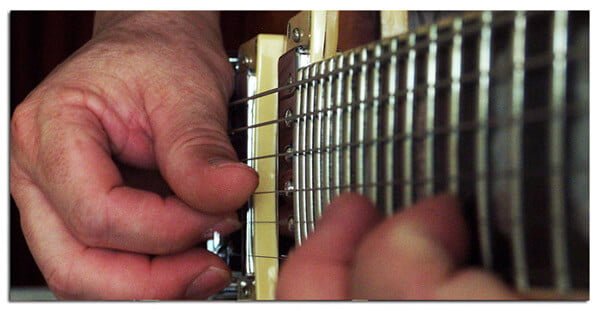
We can also block the strings with the index finger of the left hand.
As seen in the image below, the index finger is placed higher than the rest of the fingers, so that it muffles the sound of the wound strings. The index finger would remain in that position until the bending is completed.
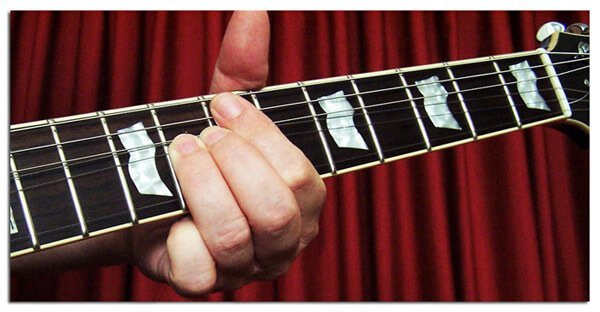
Which Notes to Bend in a Guitar Scale
A bend can be played on any note, but below are the notes on which a bend is most commonly played, and the intensity that is usually applied to that particular note.
Which Notes to Bend in a Major Scale
In the image below, we see three fragments of the Major scale in consecutive order, with the stretches marked with a pentagon, and a number that marks their intensity (1: semitone – 2: tone – 3: tone + semitone).
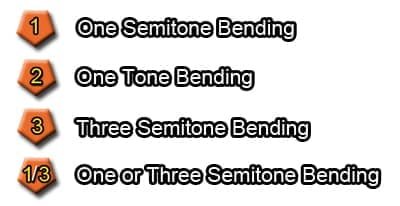
If we bend the second string (image above left), where it puts a two in the pentagon, we would go from playing a 5th to playing a 6th note.
On the same string but in the center image, we can stretch a semitone or a tone and a half, going from the 6th to the tonic or 1st. So we can finish a solo with this bending, and look like a true King.
Which Notes to Bend in a Minor Scale
We move on to the minor scale, the scale most used by guitarists for their solos. In the image on the left, on the second string, we can bend a tone (pentagon with No. 2), going from the 7th note to the tonic, and thus an ending for a solo would be perfect.

BEND on Guitar: Inverse and Unison
We can pluck two guitar strings, and perform a bend on the top string. Or if we prefer, we can bend first, and then press the unstretched note. This will give us a more intense sound in distorted sounds, or a more complete sound in clean sounds.

This type of stretch can be performed anywhere on the scale, but in the images below we have the most used areas.
Unison Bends in Major Scale
In the two images below we have the same type of bending, executed in different parts of the Major scale. We stretch the 5th note of the scale taking it to the 6th, and keep the tonic (1st) pressed.
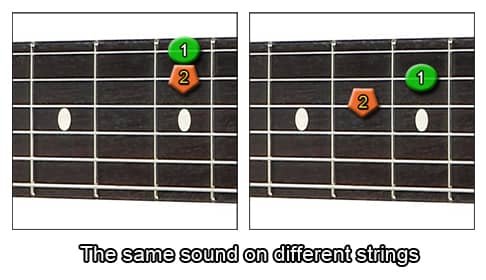
In the images below, the one we stretch would be the 2nd note, to take it to a 3rd, by holding down the 5th note. This type of stretching is one of the most used.
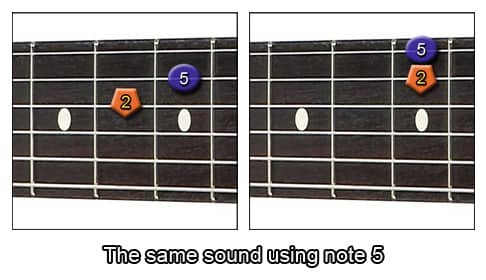
Unison Bends in Minor Scale
We move on to the minor scale, the scale for guitar solos par excellence. In the images below we have the same thing we had above, but the notes have a different position in the minor scale.
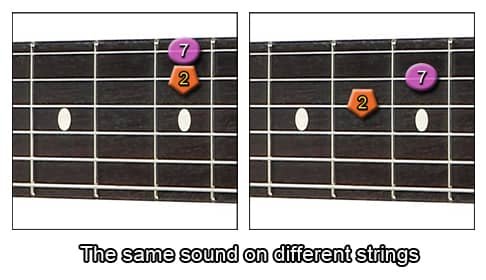
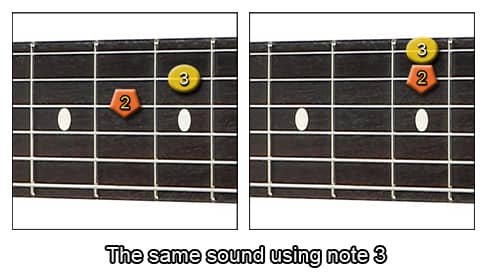
Another type of bending would be the one we can do by stretching two strings at the same time. This way we will achieve more intensity, although short distance. But just by bend a semitone, it will give us a very authentic sound.
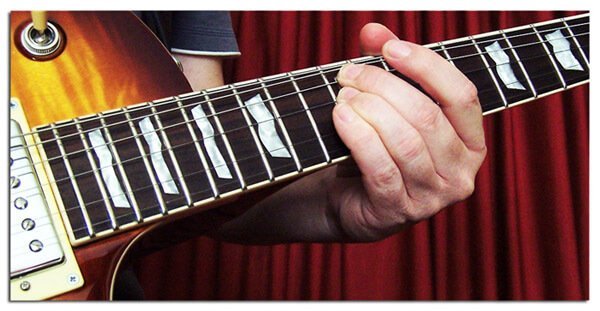
Inverse Bends for Guitar
Finally, we have the bending done in reverse. That is, first we stretch, then we press the string, and then we remove the bend. This causes an unexpected sigh-like sound.


